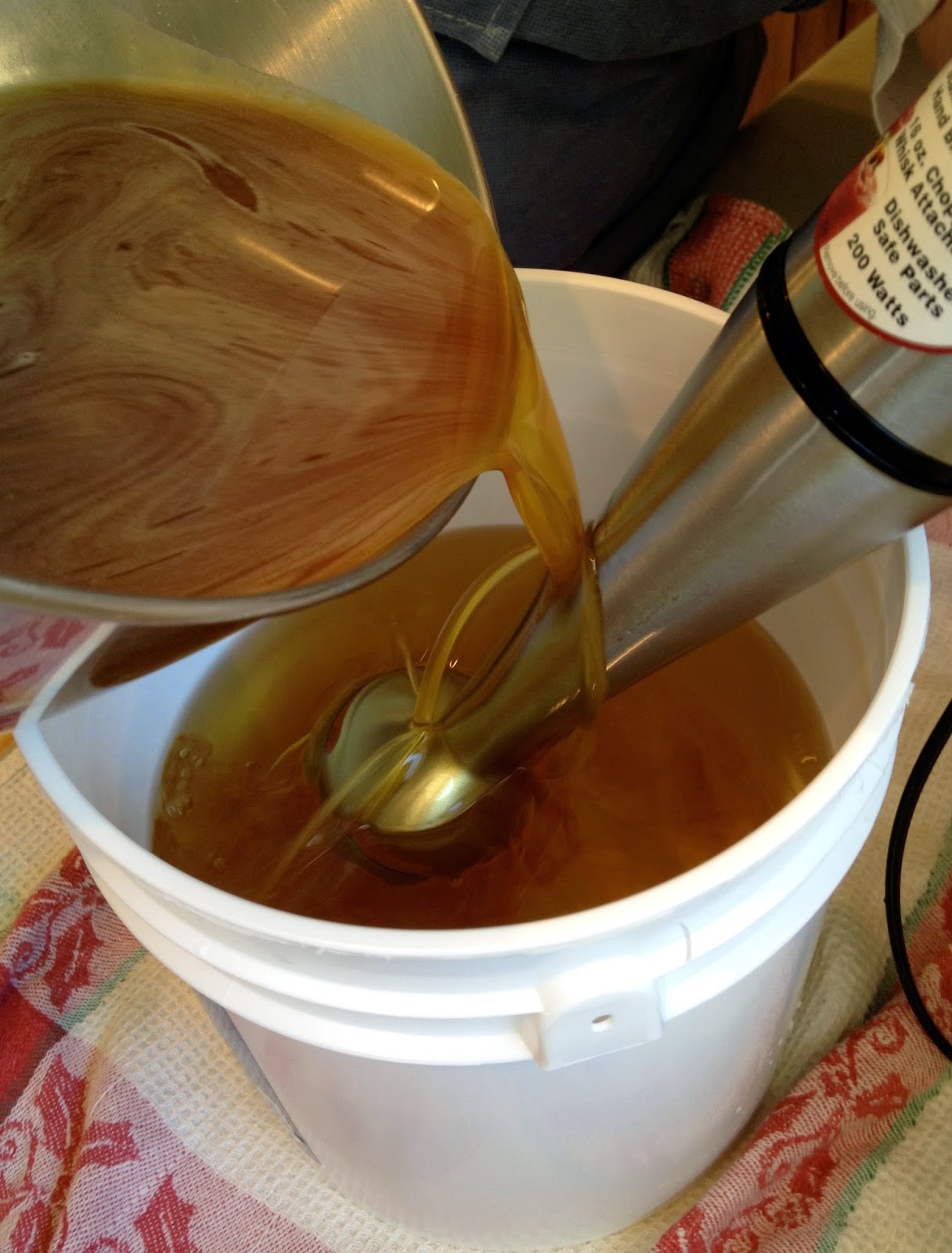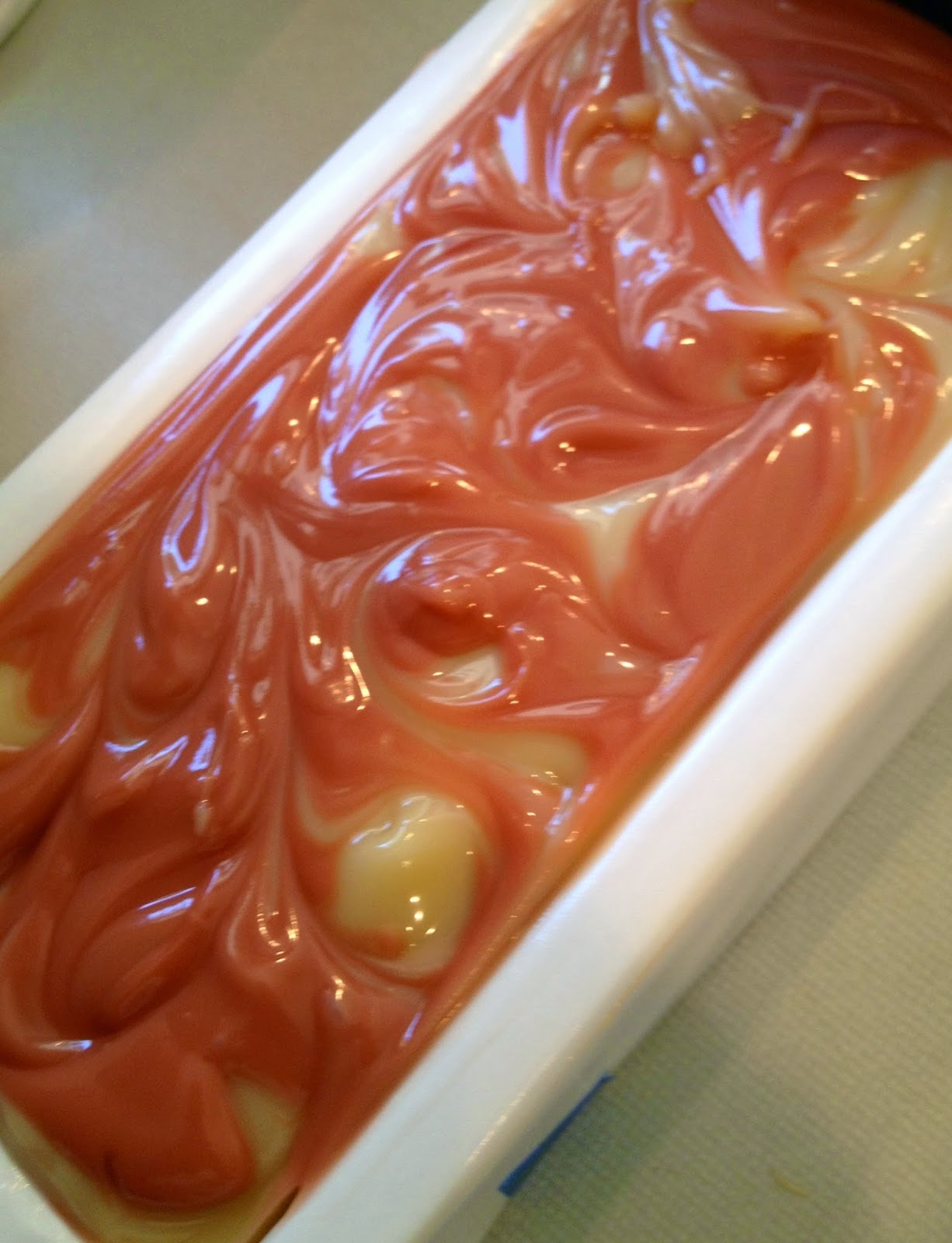Monday, July 28, 2014
We've seen recipes both online and in our books for soaps that incorporate wine rather than water for the liquid. Somehow nothing surprises us with regard to soap making. All sorts of ingredients can be used, from fruits and veggies right over to milk and wine, a veritable smorgasboard! When we stopped and thought about it, we realized that we have actually used milks including coconut, butter, and almond, fresh mint, chamomile tea, carrots, oatmeal, honey, and so forth. Why not wine?!
I (Alison) have a friend (Mike) who makes homemade wine, and he generously offered several bottles for us to use as guinea pigs in our wine soap endeavor. Can a bottle of wine be a guinea pig? In this case, oh yes. Mike gave us a nice variety of wines ranging from a sweet white to several different reds.
I decided to start with the white. My son took down the names of the wines for me as Mike boxed them for us, but he put those notes in his iPod, and I can't crack the code right now.He changes the code periodically to keep his sister out of it, and he isn't home at the moment for me to make him hand over the code.
I think Mike called the white wine something like Gewürztraminer, but as I don't speak German and I came up with that name by Googling German white wines, it is very possible that I am wrong.
The reds include a blackberry chardonnay, a malbec, a merlot, and a brunello.
From what we've read, there are a couple of different schools of thought regarding alcohol content in soap making. Some advice says that we should cook the alcohol out of the wine as it won't mix well with lye, and that in fact it would be dangerous. Others suggest that the alcohol content doesn't really matter, but that the wine should be frozen before adding the lye.
I will try it both ways to see, but for this first attempt, I decided to try removing the alcohol first.
I wanted to make the soap on Monday, so I had to get the wine into the freezer Sunday night. First I reduced the volume of the wine by half by slowly simmering the wine and cooking out the alcohol. I poured the remaining liquid into ice cube trays and let it freeze overnight.
This is the frozen wine. We had to add a little distilled water to get to the proper weight needed for the soap recipe.
You are probably getting tired of hearing "old faithful," but that has become our basic "go to" recipe. It is by far our favorite, and it never disappoints us. We mixed the oils together (coconut, palm, olive and castor) then added the lye to the frozen (slushy) wine/water combination.
This is what the lye - wine/water combination looked like once it was mixed together. Interesting that a white wine, when reduced and combined with lye, has a red tint.
We mixed the lye/wine-water into the oils and used the stick blender until we were at light trace.
Since we had decided to do a double batch to test some more new sample fragrances, each side of the divided mold would have a different scent. It is unfortunate, we think, that the scent of the wine does not really survive the reaction with the lye. I love how wine smells, and my house smelled great while the wine was simmering. But, alas, an EO or FO is needed to create a wine soap with a pleasing scent.
We tried to choose fragrance oils that somehow relate to wine. Ok. We admit that it may seem like a stretch. The Sweet Orange Chili Pepper is a wonderful fruity scent with a hint of spice, so we decided that we would use it and call the soap Sangria (I did say it was a stretch, didn't I?). As for the Tuscan Fields, well, many great wines come from Italy. Tuscany is in Italy. Grapes are grown in fields. Right? C'mon use your imagination! we sure did!
We used these two "wine related" (see above) scents.
We divided the batter into two equal parts.
We had decided to use the hanger swirl technique using only one color for each fragrance. Tuscan Fields is green and "Sangria" is the rusty red.
We mixed each color in a cup of batter
We started with a layer of uncolored batter, tamping it down after each addition.
Initially, we were only going to put one layer of color, but we realized that a cup of colored batter was more than we thought, so we ended up making several alternating layers.
Once we had all the soap layers in place we hanger swirled each side. You can see the "Sangria" side (left) isn't quite as full as the right side, the divider slipped a little and caused the batches to be a little uneven.
Here I am using the hanger tool we made to swirl the Tuscan Fields side.
Once I was finished, I added a little white and green batter to the top and added a swirl effect. I was quite pleased with how it came out.
Kathy did the same thing to the "Sangria" side. She topped it off with remaining white and colored batter then swirled.
We put the soap in the curing box then sprayed it with alcohol several times to prevent ash build up.
While we were cleaning up we noticed the great bubbles and later created from this soap.
Tuesday, July 29, 2014
We were so excited today to unmold the soap and cut it into bars, but we had to contain our excitement a bit longer. As we took the loaves from the mold, we could tell that it was still too soft to cut. We didn't want to take a chance on ruining our beautiful soap by being impatient, so we put the loaves back into the mold and will check again tomorrow.
Wednesday, July 30, 2014
Kathy cut the soap into bars today, and the results look really nice!
Sangria
Tuscan Fields
These wine soaps should be ready by September 5.
.
























No comments:
Post a Comment